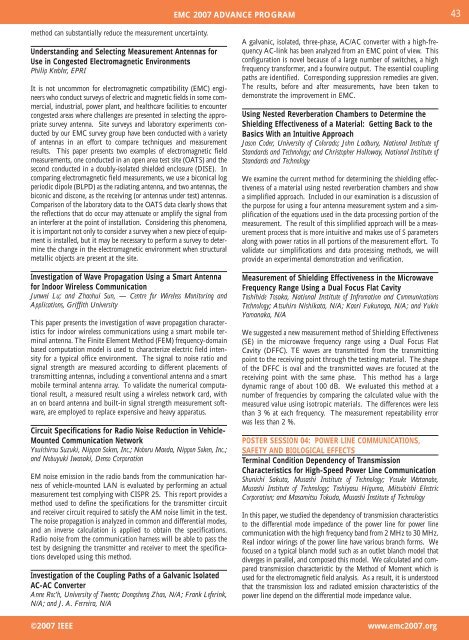2007 ieee international symposium on electromagnetic compatibility
2007 ieee international symposium on electromagnetic compatibility
2007 ieee international symposium on electromagnetic compatibility
You also want an ePaper? Increase the reach of your titles
YUMPU automatically turns print PDFs into web optimized ePapers that Google loves.
EMC <str<strong>on</strong>g>2007</str<strong>on</strong>g> ADVANCE PROGRAM 43method can substantially reduce the measurement uncertainty.Understanding and Selecting Measurement Antennas forUse in C<strong>on</strong>gested Electromagnetic Envir<strong>on</strong>mentsPhilip Keebler, EPRIIt is not uncomm<strong>on</strong> for <strong>electromagnetic</strong> <strong>compatibility</strong> (EMC) engineerswho c<strong>on</strong>duct surveys of electric and magnetic fields in some commercial,industrial, power plant, and healthcare facilities to encounterc<strong>on</strong>gested areas where challenges are presented in selecting the appropriatesurvey antenna. Site surveys and laboratory experiments c<strong>on</strong>ductedby our EMC survey group have been c<strong>on</strong>ducted with a varietyof antennas in an effort to compare techniques and measurementresults. This paper presents two examples of <strong>electromagnetic</strong> fieldmeasurements, <strong>on</strong>e c<strong>on</strong>ducted in an open area test site (OATS) and thesec<strong>on</strong>d c<strong>on</strong>ducted in a doubly-isolated shielded enclosure (DISE). Incomparing <strong>electromagnetic</strong> field measurements, we use a bic<strong>on</strong>ical logperiodic dipole (BLPD) as the radiating antenna, and two antennas, thebic<strong>on</strong>ic and disc<strong>on</strong>e, as the receiving (or antennas under test) antennas.Comparis<strong>on</strong> of the laboratory data to the OATS data clearly shows thatthe reflecti<strong>on</strong>s that do occur may attenuate or amplify the signal froman interferer at the point of installati<strong>on</strong>. C<strong>on</strong>sidering this phenomena,it is important not <strong>on</strong>ly to c<strong>on</strong>sider a survey when a new piece of equipmentis installed, but it may be necessary to perform a survey to determinethe change in the <strong>electromagnetic</strong> envir<strong>on</strong>ment when structuralmetallic objects are present at the site.Investigati<strong>on</strong> of Wave Propagati<strong>on</strong> Using a Smart Antennafor Indoor Wireless Communicati<strong>on</strong>Junwei Lu; and Zhaohui Sun, — Centre for Wireless M<strong>on</strong>itoring andApplicati<strong>on</strong>s, Griffith UniversityThis paper presents the investigati<strong>on</strong> of wave propagati<strong>on</strong> characteristicsfor indoor wireless communicati<strong>on</strong>s using a smart mobile terminalantenna. The Finite Element Method (FEM) frequency-domainbased computati<strong>on</strong> model is used to characterize electric field intensityfor a typical office envir<strong>on</strong>ment. The signal to noise ratio andsignal strength are measured according to different placements oftransmitting antennas, including a c<strong>on</strong>venti<strong>on</strong>al antenna and a smartmobile terminal antenna array. To validate the numerical computati<strong>on</strong>alresult, a measured result using a wireless network card, withan <strong>on</strong> board antenna and built-in signal strength measurement software,are employed to replace expensive and heavy apparatus.Circuit Specificati<strong>on</strong>s for Radio Noise Reducti<strong>on</strong> in Vehicle-Mounted Communicati<strong>on</strong> NetworkYouichirou Suzuki, Nipp<strong>on</strong> Soken, Inc.; Noboru Maeda, Nipp<strong>on</strong> Soken, Inc.;and Nobuyuki Iwasaki, Denso Corporati<strong>on</strong>EM noise emissi<strong>on</strong> in the radio bands from the communicati<strong>on</strong> harnessof vehicle-mounted LAN is evaluated by performing an actualmeasurement test complying with CISPR 25. This report provides amethod used to define the specificati<strong>on</strong>s for the transmitter circuitand receiver circuit required to satisfy the AM noise limit in the test.The noise propagati<strong>on</strong> is analyzed in comm<strong>on</strong> and differential modes,and an inverse calculati<strong>on</strong> is applied to obtain the specificati<strong>on</strong>s.Radio noise from the communicati<strong>on</strong> harness will be able to pass thetest by designing the transmitter and receiver to meet the specificati<strong>on</strong>sdeveloped using this method.Investigati<strong>on</strong> of the Coupling Paths of a Galvanic IsolatedAC-AC C<strong>on</strong>verterAnne Roc’h, University of Twente; D<strong>on</strong>gsheng Zhao, N/A; Frank Leferink,N/A; and J. A. Ferreira, N/AA galvanic, isolated, three-phase, AC/AC c<strong>on</strong>verter with a high-frequencyAC-link has been analyzed from an EMC point of view. Thisc<strong>on</strong>figurati<strong>on</strong> is novel because of a large number of switches, a highfrequency transformer, and a fourwire output. The essential couplingpaths are identified. Corresp<strong>on</strong>ding suppressi<strong>on</strong> remedies are given.The results, before and after measurements, have been taken todem<strong>on</strong>strate the improvement in EMC.Using Nested Reverberati<strong>on</strong> Chambers to Determine theShielding Effectiveness of a Material: Getting Back to theBasics With an Intuitive ApproachJas<strong>on</strong> Coder, University of Colorado; John Ladbury, Nati<strong>on</strong>al Institute ofStandards and Technology; and Christopher Holloway, Nati<strong>on</strong>al Institute ofStandards and TechnologyWe examine the current method for determining the shielding effectivenessof a material using nested reverberati<strong>on</strong> chambers and showa simplified approach. Included in our examinati<strong>on</strong> is a discussi<strong>on</strong> ofthe purpose for using a four antenna measurement system and a simplificati<strong>on</strong>of the equati<strong>on</strong>s used in the data processing porti<strong>on</strong> of themeasurement. The result of this simplified approach will be a measurementprocess that is more intuitive and makes use of S parametersal<strong>on</strong>g with power ratios in all porti<strong>on</strong>s of the measurement effort. Tovalidate our simplificati<strong>on</strong>s and data processing methods, we willprovide an experimental dem<strong>on</strong>strati<strong>on</strong> and verificati<strong>on</strong>.Measurement of Shielding Effectiveness in the MicrowaveFrequency Range Using a Dual Focus Flat CavityToshihide Tosaka, Nati<strong>on</strong>al Institute of Infromati<strong>on</strong> and Communicati<strong>on</strong>sTechnology; Atsuhiro Nishikata, N/A; Kaori Fukunaga, N/A; and YukioYamanaka, N/AWe suggested a new measurement method of Shielding Effectiveness(SE) in the microwave frequency range using a Dual Focus FlatCavity (DFFC). TE waves are transmitted from the transmittingpoint to the receiving point through the testing material. The shapeof the DFFC is oval and the transmitted waves are focused at thereceiving point with the same phase. This method has a largedynamic range of about 100 dB. We evaluated this method at anumber of frequencies by comparing the calculated value with themeasured value using isotropic materials. The differences were lessthan 3 % at each frequency. The measurement repeatability errorwas less than 2 %.POSTER SESSION 04: POWER LINE COMMUNICATIONS,SAFETY AND BIOLOGICAL EFFECTSTerminal C<strong>on</strong>diti<strong>on</strong> Dependency of Transmissi<strong>on</strong>Characteristics for High-Speed Power Line Communicati<strong>on</strong>Shunichi Sakuta, Musashi Institute of Technology; Yosuke Watanabe,Musashi Institute of Technology; Toshiyasu Higuma, Mitsubishi ElectricCorporati<strong>on</strong>; and Masamitsu Tokuda, Musashi Institute of TechnologyIn this paper, we studied the dependency of transmissi<strong>on</strong> characteristicsto the differential mode impedance of the power line for power linecommunicati<strong>on</strong> with the high frequency band from 2 MHz to 30 MHz.Real indoor wirings of the power line have various branch forms. Wefocused <strong>on</strong> a typical blanch model such as an outlet blanch model thatdiverges in parallel, and composed this model. We calculated and comparedtransmissi<strong>on</strong> characteristic by the Method of Moment which isused for the <strong>electromagnetic</strong> field analysis. As a result, it is understoodthat the transmissi<strong>on</strong> loss and radiated emissi<strong>on</strong> characteristics of thepower line depend <strong>on</strong> the differential mode impedance value.©<str<strong>on</strong>g>2007</str<strong>on</strong>g> IEEE www.emc<str<strong>on</strong>g>2007</str<strong>on</strong>g>.org
















